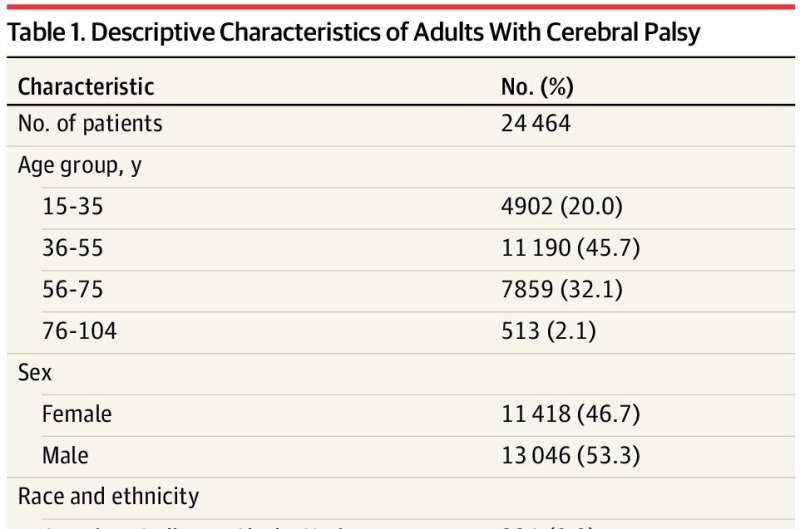This article has been reviewed according to Science X's editorial process and policies. Editors have highlighted the following attributes while ensuring the content's credibility:
fact-checked
peer-reviewed publication
trusted source
proofread
Better understanding cerebral palsy pain types could lead to better treatment

Pain management is an important component of caring for adults with cerebral palsy. However, it's the least understood comorbidity in the adult cerebral palsy population.
A study led by Mark Peterson, Ph.D., M.S., FACSM, a professor of physical medicine and rehabilitation at University of Michigan Health, found that adults living with cerebral palsy had a very high occurrence of pain, with 90% having a pain history and 74% having multiple diagnoses of pain coming from different origins such as the lower back, irritable bowels, joint arthritis and chronic headaches.
The research is published in the journal JAMA Neurology.
The study compared the prevalence of nociplastic, neuropathic, nociceptive and mixed pain subtypes in adults with cerebral palsy.
The data described combinations of pain subtypes and to assess their relation to CP subtypes.
The distribution of pain phenotypes across individual categories found that 86.3% of adults with cerebral palsy experience nociceptive pain, 45.8% experience nociplastic pain and 16.9% experience neuropathic pain.
Data for the research was collected from a 20% random sample of patients with a CP diagnosis above the age of 18 in the Medicare Fee-for-service research identifiable files from 2008 to 2020.
"We were not surprised by the extremely high prevalence of pain and pain multimorbidity, as this reflects what most patients report," said Peterson.
"This research demonstrates a much higher pain prevalence than previous research, however. We believe our data is more representative of the true pain experience of adults with cerebral palsy."
Peterson and his team want their study to shed light on the significance of chronic pain in adults with cerebral palsy to bring better pain management techniques forward.
"Many adults with cerebral palsy are prescribed opioid medication to treat their pain," said Peterson.
"This is not sustainable longterm and can cause numerous complications for patients. It is important to have a better understanding of the pain adults with cerebral palsy experience and how to manage this pain so we can form better treatment methods."
"Pain is definitely the most common complaint in our Adults with Cerebral Palsy clinic," said Edward A. Hurvitz, M.D., a professor of physical medicine and rehabilitation and s co-author on the study.
"Accurate identification of the pain type and source is critical for proper treatment."
More information: Mark D. Peterson et al, Pain Phenotypes and Pain Multimorbidity Among Medicare Beneficiaries With Cerebral Palsy, JAMA Neurology (2024). DOI: 10.1001/jamaneurol.2024.2443


















